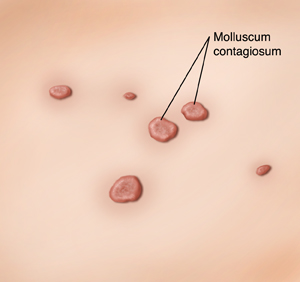Molluscum Contagiosum (Child)
Molluscum contagiosum is a common skin infection. It's caused by a poxvirus. The infection causes raised, flesh-colored bumps with central indentations on the skin. The bumps are sometimes itchy, but not painful. They may spread or form lines when scratched. Almost any skin can be affected. Common sites include the face, neck, armpit, arms, hands, and genitals.

Molluscum contagiosum spreads easily from one part of the body to another. It spreads through scratching or other contact. It can also spread from person to person. This often happens through shared clothing, towels, or objects such as toys. It has been known to spread during contact sports.
This rash is not dangerous and treatment may not be needed. But the rash can spread if it's untreated. Because it's caused by a virus, antibiotics don't help. The infection usually goes away on its own within 6 to 18 months. The infection may continue in children with a weak immune system. This may be from diabetes, cancer, or HIV.
If the bumps are bothersome or unsightly, you can have them removed. This may include scraping, freezing, or using a blistering solution or an immune modulating cream.
Home care
Your child's healthcare provider can prescribe a medicine to help the bumps or sores heal. Follow all of the provider’s instructions for giving your child this medicine.
The following are general care guidelines:
-
Discourage your child from scratching the bumps. Scratching spreads the infection. Use bandages to cover and protect affected skin and help prevent scratching.
-
Wash your hands before and after caring for your child’s rash.
-
Don't let your child share towels, washcloths, or clothing with anyone.
-
Don't give your child baths with other children because the infection can be spread to others.
-
If your child swims in public pools, cover the affected area with a watertight bandage.
-
If your child takes part in contact sports, be sure all affected skin is securely covered with clothing or bandages.
Follow-up care
Follow up with your child's healthcare provider, or as advised.
When to seek medical advice
Call your child's healthcare provider right away if any of these occur:
-
Fever (see Fever and children, below)
-
A bump shows signs of infection. These include warmth, pain, oozing, or redness.
-
Bumps appear on a new area of the body or seem to be spreading rapidly
-
Bumps appear around the eyes or genitals
Fever and children
Use a digital thermometer to check your child’s temperature. Don’t use a mercury thermometer. There are different kinds and uses of digital thermometers. They include:
-
Rectal. For children younger than 3 years, a rectal temperature is the most accurate.
-
Forehead (temporal). This works for children age 3 months and older. If a child under 3 months old has signs of illness, this can be used for a first pass. The provider may want to confirm with a rectal temperature.
-
Ear (tympanic). Ear temperatures are accurate after 6 months of age, but not before.
-
Armpit (axillary). This is the least reliable but may be used for a first pass to check a child of any age with signs of illness. The provider may want to confirm with a rectal temperature.
-
Mouth (oral). Don’t use a thermometer in your child’s mouth until they are at least 4 years old.
Use the rectal thermometer with care. Follow the product maker’s directions for correct use. Insert it gently. Label it and make sure it’s not used in the mouth. It may pass on germs from the stool. If you don’t feel OK using a rectal thermometer, ask the healthcare provider what type to use instead. When you talk with any healthcare provider about your child’s fever, tell them which type you used.
Below are guidelines to know if your young child has a fever. Your child’s healthcare provider may give you different numbers for your child. Follow your provider’s specific instructions.
Fever readings for a baby under 3 months old:
Fever readings for a child age 3 months to 36 months (3 years):
-
Rectal, forehead, or ear: 102°F (38.9°C) or higher
-
Armpit: 101°F (38.3°C) or higher
Call the healthcare provider in these cases:
-
Repeated temperature of 104°F (40°C) or higher in a child of any age
-
Fever of 100.4° F (38° C) or higher in baby younger than 3 months
-
Fever that lasts more than 24 hours in a child under age 2
-
Fever that lasts for 3 days in a child age 2 or older